Posted in Scottish Fiction, Reading Reviewed, Scottish Literature at 12:00 on 7 June 2023
John Murray, 1992, 238 p.
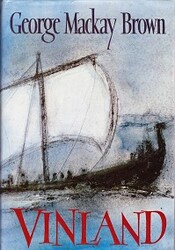 The book’s title is a misnomer as only the first section, in which young Ranald Sigmundson stows away on Leif Erikson’s ship, is actually set in any way at all in that fertile countryside. Even that sojourn is fleeting since one of the Norsemen, Wolf, reacts violently in an encounter with the indigenous skraelings as a result of which good relations are never restored. Brown takes this chance to put into Leif Erikson’s mouth a speech about how the arrival of Europeans will spell doom for the natives.
The book’s title is a misnomer as only the first section, in which young Ranald Sigmundson stows away on Leif Erikson’s ship, is actually set in any way at all in that fertile countryside. Even that sojourn is fleeting since one of the Norsemen, Wolf, reacts violently in an encounter with the indigenous skraelings as a result of which good relations are never restored. Brown takes this chance to put into Leif Erikson’s mouth a speech about how the arrival of Europeans will spell doom for the natives.
The novel is the tale of Ranald’s life, taking in his prowess as a horseman winning a race in Greenland, the brief stop in Vinland, a trip to Norway where he meets King Olaf (proud of his self-appointed status as the bringer of Christianity to Orkney,) returning to Orkney before a trip to Ireland as part of Earl Sigurd’s campaign against Brian Boru at the Battle of Clontarf (a disaster for the Orcadians but also for Boru personally,) settling in his farm at Breckness. The final, valedictory, section is titled Tir-nan-og.
Much of the intrigue of the book is taken up with the internal duels of the sons of Earl Sigurd to rule in Orkney. A matter complicated by the fact that the supreme ruler is the King of Norway and he too wants his slice. Three of Sigurd’s sons hold the islands more or less equally, but one, Thorfinn, also has lands in Caithness and Sutherland for which he pays homage to the King of Scots. Feudal land inheritance was a nasty business.
If in the end he is neglectful of his wife Ragna, since he becomes ever more reclusive as the cares of the world wear on him, Ranald lives out his life as a good man. Brown has given us here a picture of life in the Viking world just this side of the cusp of Christianity. In human relations not much has changed since.
Pedant’s corner:- “the dice was loaded against him” (‘dice’ is the plural [of die], ‘the dice were’,) “laying less eggs” (fewer eggs.)
No Comments »
Posted in Trips, War Memorials at 12:00 on 14 February 2023
I spotted this War Memorial on the eastern side of Wick when we were returning from Orkney, so of course stopped to photograph it. It’s unusual in being topped by an urn.
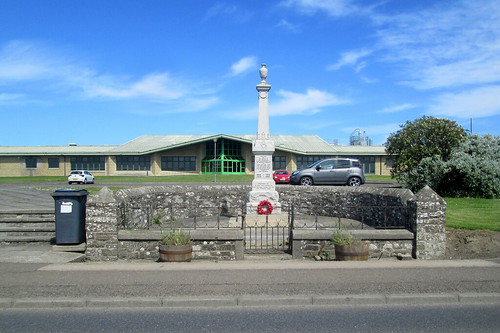
Dedication – to the men of the Ackergill and Hempriggs Estate:-

Eastern aspect:-

Western aspect:-

No Comments »
Posted in Trips at 12:00 on 13 February 2023
On the trip back from St Margaret’s Hope to Scotland (which Orcadians, rather than ‘the mainland,’ call the nearest part of Britain – to them ‘the mainland’ is Orkney’s largest island) we passed the gun batteries on South Ronaldsay.
These are I think called the Hoxa Battery.
There were gun emplacements here in both World Wars to protect Scapa Flow. These remains have the look of World War two constructions.


In 2017 I photographed them from a bit further away.
No Comments »
Posted in War Memorials, Trips at 12:00 on 12 February 2023
St Margaret’s Hope was our last stop on Orkney as it was where we picked up the ferry for Gill’s Bay in Caithness. I mentioned it in 2017. Its War Memorial is in the form of a kilted soldier atop a tapering square plinth.

The front of the memorial is dedicated to the men of South Ronaldsay who fell in the Great War:-

War Memorial from rear:-

Word War 2 Dedication, on side of memorial:-

No Comments »
Posted in Trips at 12:00 on 9 February 2023
From the car park below Cuween Hill Chambered Cairn could be seen at the top of the hill what looked like standing stones.

After visiting the cairn we ascended the hill to the stones and discovered they were modern and made by stacking small slabs on one another:-

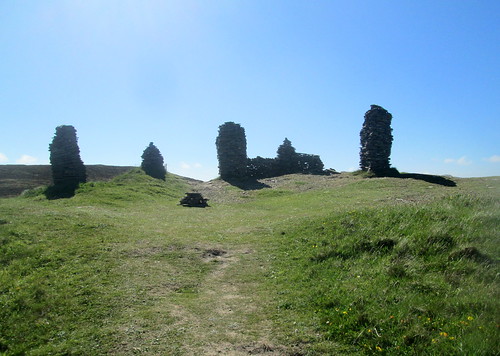



Close up on stacked stones. Bay of Firth in background:-

No Comments »
Posted in History, Trips at 12:00 on 7 February 2023
The interior of Cuween Hill Chambered Cairn is reasonably spacious with plenty of room to stand up and various side chambers. The first of these photos was taken with the good lady’s camera phone:-





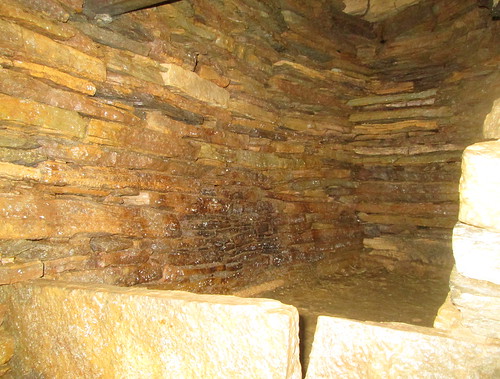
End wall with chamber entrance:-

Roof:-


No Comments »
Posted in History, Trips at 12:00 on 5 February 2023
Cuween Hill Chambered Cairn, Orkney, lies on Cuween Hill, south of Finstown on a path off the Old Finstown Road.
There’s a small car park – about two cars worth – but then there’s a bit of a climb (though not far) to the cairn.
Cairn:-

Information board:-

Entrance. The access is restricted. You have to crawl or stoop very low to get through the passage though once inside you can stand up very easily:-
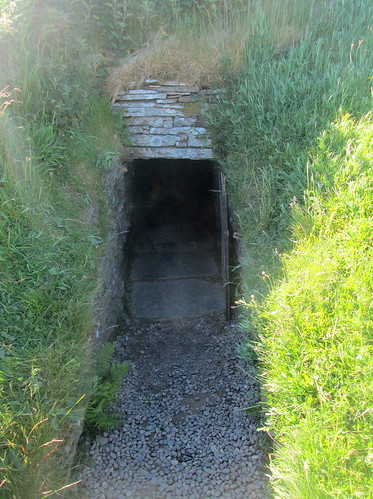
Entrance from inside:-

2 Comments »
Posted in Trips, History, Museums at 12:00 on 2 February 2023
Stepping into the main buidling at Kirbuster Farm Museum is indeed like stepping into the past. It was inhabited up to the 1960s and opened as a museum in 1986 – the last unrestored ‘firehoose’ in Northen Europe.
We had wondered whether to visit this museum but it turned out to be extremely interesting. The guide was a lovely, chatty woman. We were the only people visiting at the time so she may have been lonely.
Main bedroom:-

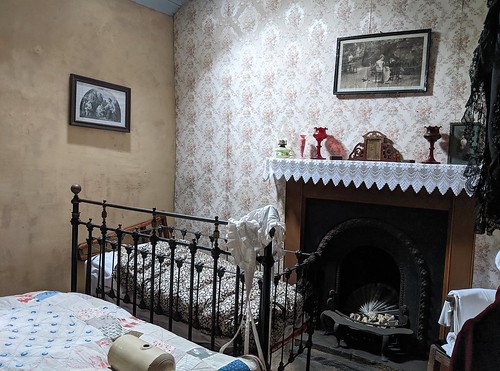
Sitting room:-

The harmonium in the sitting room reminded me of the one in my great uncle’s house (he was a piano/music teacher and church organist):-
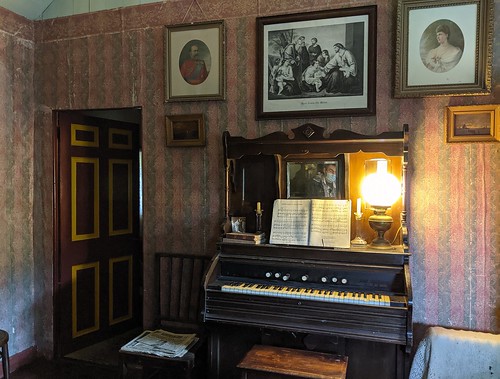
Wall mounted alarm clock:-

Box-bed in kitchen:-


Cruisie lamp:-

There was another building which contained loads of old farm equipment. Some of their uses were a bit mysterious:-

No Comments »
Posted in Curiosities, Trips at 20:30 on 31 January 2023
Part of the central portion of Orkney’s mainland is known by the name of Harray.
On the way up to Kirbuster Farm Museum we passed a local ceramic artist’s workshop and retail premises. The business’s name is obviously playing on a more widely known enterprise.

No Comments »
Posted in War Graves, War Memorials at 12:00 on 25 January 2023
Finstown is a small settlement about halfway between Kirkwall and Stromness. Its War Memorial is a simple obelisk lying beside the A 965 road through the village:-

Closer view:-
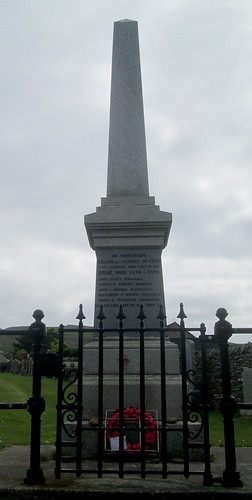
Dedication “to the soldiers and sailors of Firth.” (Finstown lies on the Bay of Firth,) and names Flett-Hourston:-
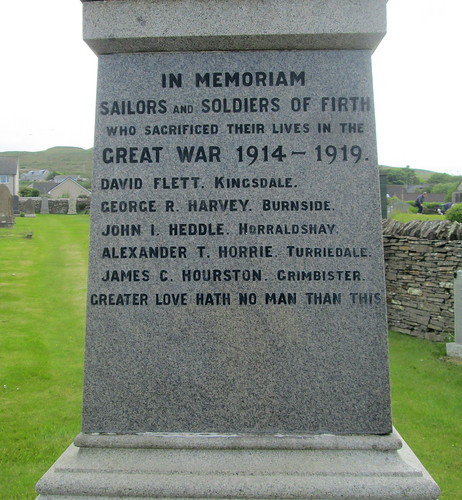
Names Sclater-Turfus:-
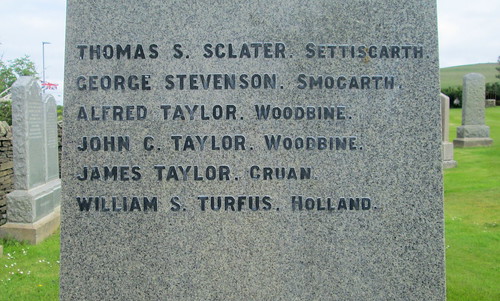
Names Kent – Scarth:-
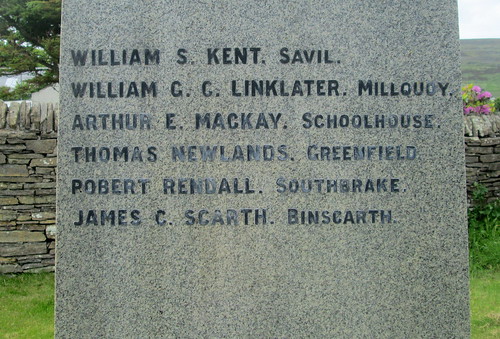
World War 2 Dedication and Names:-

In the graveyard behind the memorial lie two Commonwealth War Graves, both from World War 2.
Marine N Isbister, RML, HMS Proserpine, 8/7/1944, aged 24, a local whose name is on the War Memorial:-

Lance Bombardier J M Bews, Royal Artillery, 26/3/1941, aged 20:-

No Comments »
 The book’s title is a misnomer as only the first section, in which young Ranald Sigmundson stows away on Leif Erikson’s ship, is actually set in any way at all in that fertile countryside. Even that sojourn is fleeting since one of the Norsemen, Wolf, reacts violently in an encounter with the indigenous skraelings as a result of which good relations are never restored. Brown takes this chance to put into Leif Erikson’s mouth a speech about how the arrival of Europeans will spell doom for the natives.
The book’s title is a misnomer as only the first section, in which young Ranald Sigmundson stows away on Leif Erikson’s ship, is actually set in any way at all in that fertile countryside. Even that sojourn is fleeting since one of the Norsemen, Wolf, reacts violently in an encounter with the indigenous skraelings as a result of which good relations are never restored. Brown takes this chance to put into Leif Erikson’s mouth a speech about how the arrival of Europeans will spell doom for the natives.















































